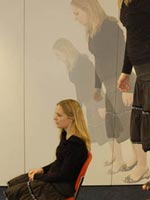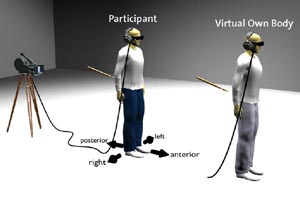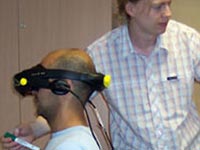This article is reposted from the old Wordpress incarnation of Not Exactly Rocket Science.
![]() The idea of an out-of-body experiences seems strange and hokey - certainly not one that would grace one of the world's top scientific journals. So it may seem surprising that two years ago, Science published not one, but two papers that considered the subject through the lens of scientific scrutiny.
The idea of an out-of-body experiences seems strange and hokey - certainly not one that would grace one of the world's top scientific journals. So it may seem surprising that two years ago, Science published not one, but two papers that considered the subject through the lens of scientific scrutiny.
 Out-of-body experiences are rare and can be caused by epileptic fits, neurological conditions such as strokes and heavy drug abuse. Clearly, they are triggered when something goes wrong in our brains. And as usual for the brain, something going wrong can tell us a lot about what happens the rest of the time.
Out-of-body experiences are rare and can be caused by epileptic fits, neurological conditions such as strokes and heavy drug abuse. Clearly, they are triggered when something goes wrong in our brains. And as usual for the brain, something going wrong can tell us a lot about what happens the rest of the time.
Simply put, if we very rarely have an out-of-body experience, why is it that for the most part we have 'in-body' experiences? It's such a fundamental part of our lives that we often take it for granted, but there must be some mental process that ensures that our perceptions of 'self' are confined to our own bodies. What is it?
Two groups of scientists have taken steps to answering these questions using illusion and deception. They managed to experimentally induce mild out-of-body experiences in healthy volunteers, by using virtual reality headsets to fool people into projecting themselves into a virtual body.
Bigna Lenggenhager and colleagues from the Ecole Polytechnique Fédérale de Lausanne accomplished this with a version of the rubber hand illusion. In the original, a person is made to think that a fake hand is theirs by simultaneously stroking the visible fake one and the hidden real one.
In Lenggenhager's version, volunteers watched their own backs as filmed by a camera behind them and projected in front of them with a video headset. Their backs were then stroked with a highlighter at the same time as the virtual body's.
 Later, the volunteers said that the sensation they felt was caused by the highlighter stroking their virtual back. They felt as if the virtual body was their own, in the same way that people fall for the rubber hand illusion.
Later, the volunteers said that the sensation they felt was caused by the highlighter stroking their virtual back. They felt as if the virtual body was their own, in the same way that people fall for the rubber hand illusion.
Lenggenhager demonstrated this confusion with a simple test - she removed the volunteers' headsets, blindfolded them, guided them back a few steps and asked them to return to their original spot. If their virtual and real backs were stroked in sync, they overshot their actual location and stopped at a spot closer to the position of their virtual bodies.
This drift in position wasn't due to a simple error in judgment. When the virtual body was replaced with a simple block or when the body and image were stroked out of time, the volunteers didn't drift significantly far from their original mark.
Henrik Ehrsson from University College London found similar results when he used two cameras set up behind seated volunteers to send them stereoscopic images of their own backs. He then touched the volunteers' chests with a plastic rod, while simultaneously using another to prod a space just in under the cameras.
Even though the volunteers felt something on their chest, they saw Ehrsson's arm moving behind their backs. The illusion worked - they felt that they were sitting behind their own bodies, watching their own backs. And just like Lenggenhager's study, if Ehrsson poked the real and virtual people asynchronously, the illusion didn't work.
 Ehrsson is convinced at the persuasiveness of the illusion - after all, he's tried it himself. "You really feel that you are sitting in a different place in the room and you're looking at this thing in front of you that looks like yourself, and you know it's yourself but it doesn't feel like yourself," he said. "It's almost like you're looking at a dummy."
Ehrsson is convinced at the persuasiveness of the illusion - after all, he's tried it himself. "You really feel that you are sitting in a different place in the room and you're looking at this thing in front of you that looks like yourself, and you know it's yourself but it doesn't feel like yourself," he said. "It's almost like you're looking at a dummy."
As further proof that the illusion worked, Ehrsson swung a hammer at a point below the camera, as if to hurt the virtual body. And sure enough, the volunteers' skin conductance response, a measure of emotional arousal, went up. They had registered the threat to the virtual body as a threat to themselves.
These two studies suggest that our brain compiles our usual 'in-body' experiences by adding together information from our various senses, particularly sight and touch. In both experiments, vision was the dominant factor
Neither study really replicates a full out-of-body experience though, and Lenggenhager is quick to admit this. While her volunteers felt 'weird' or 'strange' none of them felt the full sense of disembodiment or the shift in perspective that characterise these incidents. Some element of the experiences must have been missing, and Lenggenhager suggests that disruption to our balance systems may be it.
 Nonetheless, the studies tell us a lot about how our brains generate a sense of self. They compile our usual 'in-body' experiences by adding together information from our sense, including, at the very least, sight and touch. Our brains will choose interpretations that fit with the information from these senses, and apparently, vision is most important. It can override and modify the information from touch.
Nonetheless, the studies tell us a lot about how our brains generate a sense of self. They compile our usual 'in-body' experiences by adding together information from our sense, including, at the very least, sight and touch. Our brains will choose interpretations that fit with the information from these senses, and apparently, vision is most important. It can override and modify the information from touch.
But Lenggenhager's work also shows that our higher brain functions have something to add too. After all, her illusion didn't work when the virtual body was a simple block and not a person so some part of the brain must reject the information from the senses if can't be reconciled into a sensible model.
For now, full simulated out-of-body experiences elude us but these studies open several new research doors. Lenggenhager's earlier work suggested that out-of-body experiences can be produced by electrically stimulating the junction between our temporal and parietal lobes. Now, virtual reality illusions can be used to work out how this area contributes to our self-consciousness.
It could even be used to see if self-consciousness, a trait that some people think is unique to human, exists in primates and other animals.
More on illusions:
Since this post was written, Ehrsson conducted an even more impressive experiment, where he convinced people that they'd swapped bodies with someone else.
- The Quantum Leap effect - creating a body-swapping illusion
- Electrical stimulation produces feelings of free will
- Pain in the eye of the beholder
- Unconscious brain activity shapes our decisions
References:
- Miller. 2007. Out-of-body experiences enter the laboratory. Science 317: 1020-1021.
- Lenggenhager, Tadi, Metzinger & Blanke. 2007. Video ergo sum: manipulating bodily self-consciousness. Science 317: 1096-1099.
- Ehrsson. 2007. The experimental induction of out-of-body experiences. Science 317: 1048.
- Log in to post comments




Good read. I wondered about this alot when I was living in Virginia and visited a theme park regularly there. They had a virtual reality booth where 20 or so people would interact with a display as well as poking and pushing each other. It really gave you a sense of being in someone else's body. Even if it wasn't stimulating the correct part of the brain for the out of body experience, it felt like it.
By the way, the link at the end "swapped bodies with someone else", goes to a 404 error page.